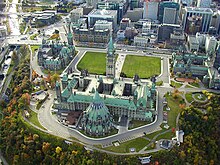
The Canadian Parliament Buildings are the parliament buildings housing the Parliament of Canada, located on Parliament Hill, Ottawa, Ontario, Canada.

The Canadian Parliament Buildings are the parliament buildings housing the Parliament of Canada, located on Parliament Hill, Ottawa, Ontario, Canada.
The Parliament Buildings are three edifices arranged around three sides of Parliament Hill's central lawn, the use and administration of the spaces within each building overseen by the speakers of each chamber of the legislature. [1] The Centre Block (completed 1927, replaced 1866 fire-ravaged original) has the Senate and Commons chambers, and is fronted by the Peace Tower on the south facade, with the Library of Parliament (completed 1876) at the building's rear. The East Block (completed 1866) and West Block (completed 1865) each contain ministers' and senators' offices, as well as meeting rooms and other administrative spaces.
Gothic Revival has been used as the unifying style of all three structures, though the Centre Block is a more modern Gothic Revival, while the older East and West Blocks are of a Victorian High Gothic.

This collection is one of the world's most important examples of the Gothic Revival style; while the buildings' manner and design are unquestionably Gothic, they resemble no building constructed during the Middle Ages. The forms were the same, but their arrangement was uniquely modern. The parliament buildings also departed from the Medieval models by integrating a variety of eras and styles of Gothic architecture, including elements from Britain, France, the Low Countries, and Italy, all in three buildings. In his 1867 Hand Book to the Parliamentary and Departmental Buildings, Canada, Joseph Bureau wrote
The style of the Buildings is the Gothic of the 12th and 13th Centuries, with modifications to suit the climate of Canada. The ornamental work and the dressing round the windows are of Ohio sandstone. The plain surface is faced with a cream-coloured sandstone of the Potsdam formation, obtained from Nepean, a few miles from Ottawa. The spandrils [ sic ] of the arches, and the spaces between window-arches and the sills of the upper windows, are filled up with a quaint description of stonework, composed of stones of irregular size, shape and color, very neatly set together. These with the Potsdam red sandstone employed in forming the arches over the windows, afford a pleasant variety of color and effect, and contrast with the general masses of light coloured sandstone, of which the body of the work is composed. [2]

The sculptural ornament is overseen by the Dominion Sculptor. [3] Five people have held the position since its creation in 1936: Cléophas Soucy (1936–50), William Oosterhoff (1949–62), Eleanor Milne (1962–93), Maurice Joanisse (1993–2006) and Phil R. White (2006–present). [1]
The only structure on Parliament Hill to have been purposefully demolished was the old Supreme Court building, which stood behind the West Block and housed the Supreme Court of Canada between 1889 and 1945. Throughout the 1950s and 1960s, there were proposals to demolish other parliamentary precinct buildings, including the Library of Parliament and West Block for new structures, and the East Block for parking, but none of these plans were adopted. [4] Instead, renovations were undertaken to the East Block, beginning in 1966.

In 2002, an extensive $1 billion renovation project began across the parliamentary precinct, [5] [6] [7] specifically focusing on masonry restoration, asbestos removal, vehicle screening, parking, electrical and mechanical systems, and improved visitors' facilities. [8] The Library of Parliament and Peace Tower, as well as some exterior areas of masonry on the Centre Block have so far been completed, though focus has shifted to the West Block due to its rapidly deteriorating cladding. In 2018, when the Centre Block is slated to be closed for ten years to carry out an extensive interior restoration and upgrade, the inner courtyard of the newly renovated West Block will be enclosed and fitted with a temporary chamber for the House of Commons while the Senate will be temporarily relocated down Wellington St. in The Government Conference Centre. Restoration of the East block is set to commence upon completion of Centre Block's restoration. [8]

Parliament Hill, colloquially known as The Hill, is an area of Crown land on the southern bank of the Ottawa River that houses the Parliament of Canada in downtown Ottawa, Ontario. It accommodates a suite of Gothic revival buildings whose architectural elements were chosen to evoke the history of parliamentary democracy. Parliament Hill attracts approximately three million visitors each year. The Parliamentary Protective Service is responsible for law enforcement on Parliament Hill and in the parliamentary precinct, while the National Capital Commission is responsible for maintaining the nine-hectare (22-acre) area of the grounds.

Rideau Hall is the official residence of the governor general of Canada, the representative of the monarch of Canada. Located in Ottawa, the capital of the country on a 36-hectare (88-acre) estate at 1 Sussex Drive. The main building consisting of approximately 175 rooms across 9,500 square metres (102,000 sq ft), and 27 outbuildings around the grounds. Rideau Hall's site lies just outside the centre of Ottawa. It is one of two official vice-regal residences maintained by the federal Crown, the other being the Citadelle of Quebec.

The Canadian Museum of Nature is a national natural history museum based in Canada's National Capital Region. The museum's exhibitions and public programs are housed in the Victoria Memorial Museum Building, a 18,910-square-metre structure (203,500 sq ft) in Ottawa, Ontario. The museum's administrative offices and scientific centres are housed at a separate location, the Natural Heritage Campus, in Gatineau, Quebec.

The Office of the Prime Minister and Privy Council building, formerly known as the Langevin Block, is an office building facing Parliament Hill in Ottawa, Ontario, Canada. As the home of the Privy Council Office and Office of the Prime Minister, it is the working headquarters of the executive branch of the Canadian government.
The Peace Tower is a focal bell and clock tower sitting on the central axis of the Centre Block of the Canadian parliament buildings in Ottawa, Ontario. The present incarnation replaced the 55-metre (180 ft) Victoria Tower, after the latter burned down in 1916, along with most of the Centre Block; only the Library of Parliament survived. It serves as a Canadian icon and had been featured prominently on the Canadian twenty-dollar bill, directly adjacent to the depiction of Queen Elizabeth II, until the change to polymer.
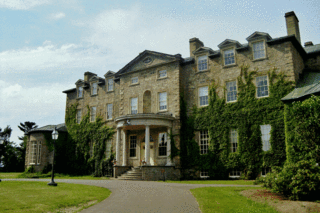
Government House is the official residence of the Lieutenant Governor of New Brunswick. Located in Fredericton, it stands on a 4.5 ha estate along the Saint John River in the provincial capital at 51 Woodstock Road; while the equivalent building in many countries has a prominent, central place in the territorial capital, the site of New Brunswick's Government House is relatively unobtrusive within Fredericton, giving it more the character of a private home.
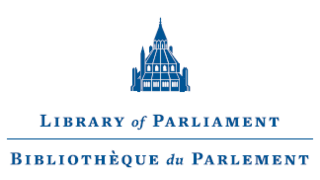
The Library of Parliament is the main information repository and research resource for the Parliament of Canada. The main branch of the library sits at the rear of the Centre Block on Parliament Hill in Ottawa, Ontario. The library survived the 1916 fire that destroyed Centre Block. The library has been augmented and renovated several times since its construction in 1876, the last between 2002 and 2006, though the form and decor remain essentially authentic. The building today serves as a Canadian icon, and appears on the obverse of the Canadian ten-dollar bill.
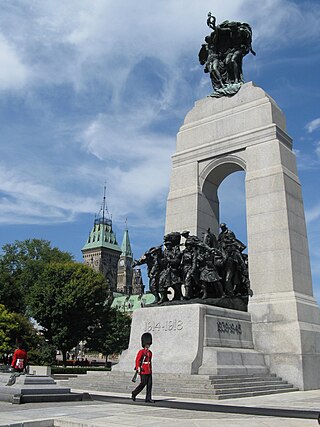
The National War Memorial, titled The Response, is a tall, granite memorial arch with accreted bronze sculptures in Ottawa, Ontario, designed by Vernon March and first dedicated by King George VI in 1939. Originally built to commemorate the Canadians who died in the First World War, it was in 1982 rededicated to also include those killed in the Second World War and Korean War and again in 2014 to add the dead from the Second Boer War and War in Afghanistan, as well as all Canadians killed in all conflicts past and future. It now serves as the pre-eminent war memorial of 76 cenotaphs in Canada. In 2000, the Tomb of the Unknown Soldier was added in front of the memorial and symbolizes the sacrifices made by all Canadians who have died or may yet die for their country.

The Centre Block is the main building of the Canadian parliamentary complex on Parliament Hill, in Ottawa, Ontario, containing the House of Commons and Senate chambers, as well as the offices of a number of members of parliament, senators, and senior administration for both legislative houses. It is also the location of several ceremonial spaces, such as the Hall of Honour, the Memorial Chamber, and Confederation Hall.

The Ontario Legislative Building is a structure in central Toronto, Ontario, Canada. It houses the Legislative Assembly of Ontario, and the viceregal suite of the Lieutenant Governor of Ontario and offices for members of the provincial parliament (MPPs). The building is surrounded by Queen's Park, sitting on that part south of Wellesley Street, which is the former site of King's College, which was leased from the university by the municipal government of Toronto in 1859, for a "peppercorn" payment of CAD$1 per annum on a 999-year term. The southern portion of the site was later handed over to the provincial government.

The East Block is one of the three buildings on Canada's Parliament Hill, in Ottawa, Ontario, containing offices for parliamentarians, as well as some preserved pre-Confederation spaces.
The Legislative Council of the Province of Canada was the upper house for the Province of Canada, which consisted of the former provinces of Lower Canada, then known as Canada East and later the province of Quebec, and Upper Canada, then known as Canada West and later the province of Ontario. It was created by The Union Act of 1840. With the lower house, the Legislative Assembly of the Province of Canada, the two houses constituted the Parliament of the Province of Canada.

The Church and Friary of St Francis, known locally as Gorton Monastery, is a Grade II* listed former Franciscan friary in Gorton, Manchester, England. It was designed by the noted Victorian architect Edward Welby Pugin and built 1866–1872. Gorton Monastery is a noted example of Gothic Revival architecture.
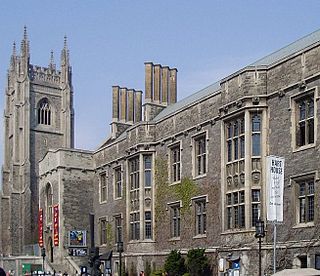
Gothic Revival architecture in Canada is an historically influential style, with many prominent examples. The Gothic Revival style was imported to Canada from Britain and the United States in the early 19th century, and it rose to become the most popular style for major projects throughout the late 19th and early 20th centuries.

The West Block is one of the three buildings on Parliament Hill, in Ottawa, Ontario. Since 28 January 2019, it has housed the interim House of Commons Chamber, installed to accommodate the House while the Centre Block is closed. The West Block also houses offices for parliamentarians, a branch of the Library of Parliament, committee rooms, and some preserved pre-Confederation spaces.

The Queen's Gates is the formal entrance to Parliament Hill, the location of the Canadian parliament buildings, in Ottawa, Ontario. Built in 1872 and set into the fence, known as the Wellington Wall, between piers designed in the Victorian High Gothic style that was fashionable in Canada at the time, the gates sit on the central axis of the hill's landscaping, in line with the Centennial Flame and Peace Tower beyond, and open onto Wellington Street.
Phil R. White is a Canadian artist and sculptor. He is the Dominion Sculptor of Canada, a position whose duties include the creation of original works of art in sculpture. His works are primarily in figurative art. He is an architectural sculptor and carver and creates works in stone, wood, and bronze.

Thomas Stent was an architect in New York City in the United States. He assisted Alexander Saeltzer on the Astor Public Library, and was the architect for its 1879–1881 expansion.
The Parliament Hill Rehabilitation is a series of ongoing rehabilitation and preservation projects at the complex on Parliament Hill, in Ottawa, Ontario. The $3-billion project aims to preserve and rehabilitate the Parliament of Canada and various buildings within the Parliamentary Precinct.

St Patrick's Church is a heritage-listed Roman Catholic church at Church Street, Gympie, Gympie Region, Queensland, Australia. It was designed by Francis Drummond Greville Stanley and built from 1883 to 1935. It was added to the Queensland Heritage Register on 20 February 1995.